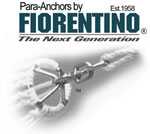|
|
Frequently Asked Questions by Today's Sailors learn more about your individual rigging requirements |
1. Small Vs Large Diameter - If you're not sure whether to use a small or large para-anchor, going larger may be the better choice. Larger para-anchors provide maximum drift control.
2. Heaving to makes a difference - Sailboats that heave to in most cases can use a smaller para-anchor because the boat's hull creates more resistance when it drags through the water. Another option is to deploy one straight off the bow. Heaving to allows more flexibility on Fiorentino's size chart. For example, a 36" sailboat with a full keel and cruising weight of 20,000 lbs. can heave to nicely with a 9' para-anchor. A 12' para-anchor is needed when deploying the para-anchor straight off the bow.
3. Windage also matters - Owners of multihull sailboats and power vessels with super structures or towers should consider going one size up from what they would normally choose.
* 4. Primary use - How you plan to use your para-anchor determines the size needed. Decide whether you use your para-anchor primarily for comfort, safety, or work. For example, the research vessel "Mako" is an 80-foot, 143-gross ton ship that effectively uses a 24' Fiorentino para-anchor to stabilize the boat. That means crew members sleep more comfortably. If safety is the primary concern, a 28- to 34-foot anchor is a better choice. If the Mako were a commercial fishing boat, the better choice would be a 34' to 40' para-anchor to completely stabilize the boat for fishing. Fiorentino's Offshore Para-Anchors are built with exceptional durability and strength in mind to handle larger vessels.
| Cruising Weight | Boat Length | Anchor Size |
| 2000 | 20' | 3' |
| 10,000 | 30' | 6' |
| 20,000 | 40' | 9' |
| 30,000 | 45' | 12' |
| 40,000 | 50' | 16' |
| 46,000 | 60' | 18' |
| 50,000 | 65' | 21' |
| *over 50,000 | *over 65' | 24' - 40' |
 Fiorentino
Para Anchor Size Chart
Fiorentino
Para Anchor Size Chart